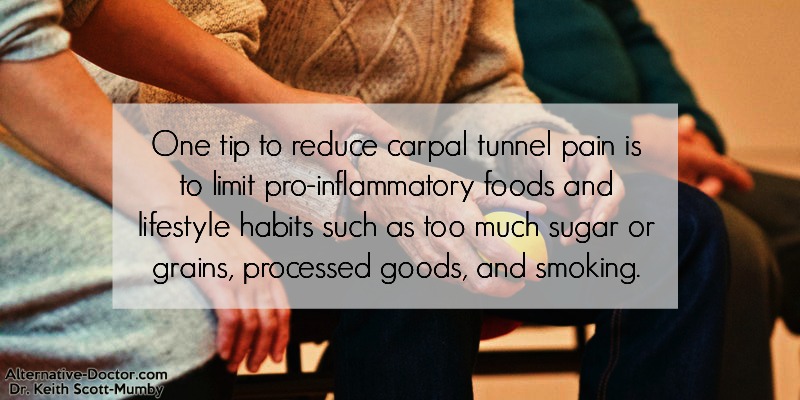You can get carpal tunnel relief without surgery. Approximately 8 million people in the United States suffer from this condition.
What is Carpal Tunnel Syndrome (CTS)?
This condition affects the nerves of your wrists (not the muscles as so many think). Once again, we’re dealing with an inflammatory disorder that can affect one or both wrists and is typically due to repetitive motion activity. If a large portion of your day is spent doing the exact same thing over and over again, it can gradually lead to nerve damage.
CTS is the number one cause of work-related injuries, resulting in the most lost time from employment, and is the most common nerve-related injury in the upper body.
The U.S. Department of Labor, Occupational Safety and Health Administration (OSHA) reported that carpal tunnel resulted in $20 billion paid to worker’s compensation.
Risk factors of carpal tunnel syndrome…
- Gender (women have three times higher risk than men)
- Tobacco use
- Being overweight or obese
- Excessive alcohol consumption
- Repetitive motion or physical trauma to area
- Existing auto-immune disease
- Diabetes, gout, or pregnancy
- Machinery vibration of wrist
People who type a lot, cashiers pulling groceries over register scanners, or those who work on factory machinery are examples of repetitive motion jobs that may affect the wrists over time but the exact cause may not be identifiable.
Damage can occur rapidly over a few weeks or could take many years to be noticeable. Pain levels vary – from mild to excruciating to completely incapacitating – from person to person. Finding relief from carpal tunnel may become increasingly harder.
The tissues around the wrist become inflamed and swollen, pressing on the median nerve. Ignored or left untreated, CTS may wear away the outer insulation of the nerve.
Though surgical solutions such as carpal tunnel release are the standard solution suggested by doctors (more than 460,000 of these procedures are done in the U.S. annually), it’s simply not an option for everyone and some damage cannot be reversed once permanent nerve damage occurs.

Symptoms of Carpal Tunnel
- Weakness of the hand
- Numbness, tingling, or trembling of the hands
- Decreased motor skills in hands
- Persistent or recurring pain or throbbing in wrist, palm, or fingers
- Pain that travels to forearm or shoulder
Long-term carpal tunnel relief may be difficult if you continue to perform the same tasks that caused the nerve to pinch initially.
6 Tips to Reducing the Pain Naturally
- Take regular breaks from repetitive tasks such as typing, sewing, playing an instrument, or working heavy machinery. Allow your hands to rest for 15 minutes.
- Pay attention to how much you’re lifting, how hard you’re typing, or how deep you press pen into paper when you write. These activities put strain on your median nerve.
- Avoid extreme cold that makes pain and stiffness worse. If you work in the cold, wear gloves and take breaks to wiggle your fingers and rest.
- Gently massage the area around your wrist with a carrier oil (coconut) and eucalyptus, wintergreen, or cypress essential oils to help manage pain during the day. Mix up a bit to keep with you while you work. One drop of carrier oil for each drop of essential oil to avoid skin irritation.
- Follow an anti-inflammatory diet that includes fatty fish, nuts and seeds, healthy fats, leafy greens, and plenty of water. These foods help to naturally lubricate joints from the inside out.
- Limit pro-inflammatory foods and lifestyle habits such as too much sugar or grains, processed goods (bagged, boxed, or canned), fast foods, excessive alcohol consumption, and smoking.
Pain can be cruel when ignored. It gradually erodes quality of life and the ability to enjoy simple pleasures. Chronic pain is misery because patients learn to have little hope of a resolution – and the pain will always come back.
Of the many reasons people visit doctors and hospitals around the world, pain is number one. Nobody likes it and we’ll all do just about anything to make it stop. Finding carpal tunnel relief is no different than chronic backpain, sciatica, tooth pain, and so on.
You want it to stop. You need it to stop.
Maybe you don’t have insurance to see a doctor or maybe the doctors you’ve seen can’t help. Whatever the case, you need help.
Let me help. There’s a better approach to pain management. Let me share a vast array of safe, effective pain control that also addresses the root cause.
Read my book “Natural Pain Relief” to learn some amazingly effective nature-based remedies for treating the number one reason for disability in the world: chronic pain. It’s not woo-woo science – many of these techniques are modern.
What matters is that they work for you. If you suffer from pain that never stops…this is the book for you.
